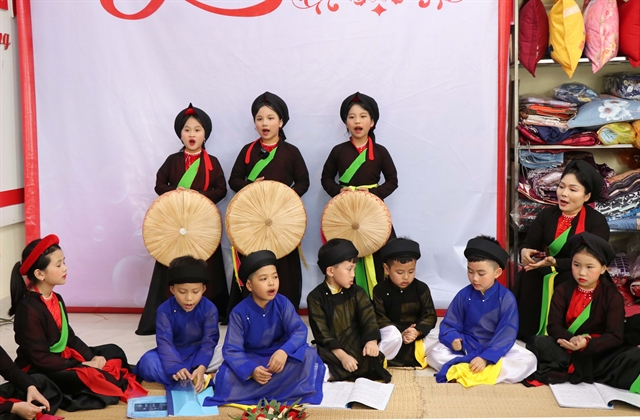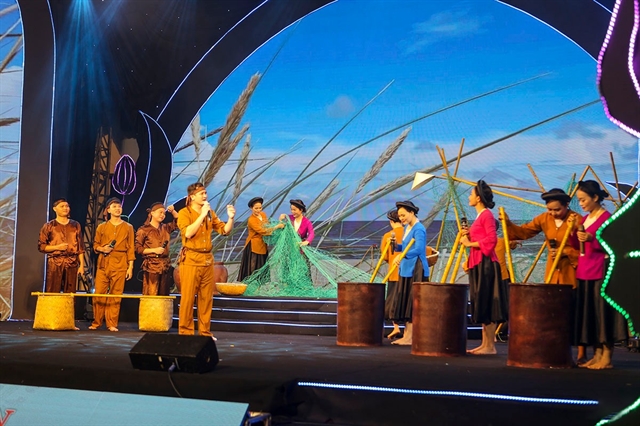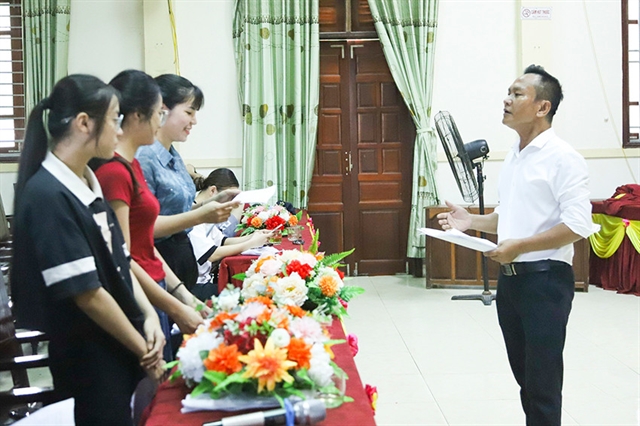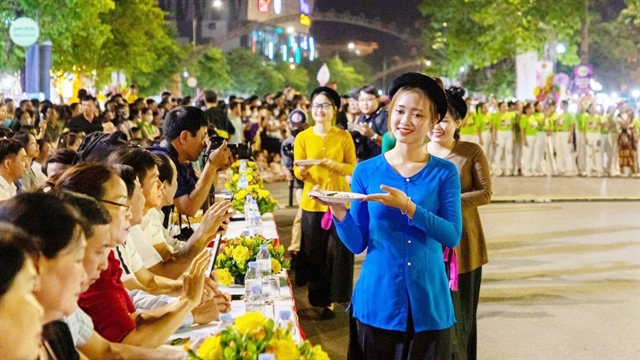 Sunday/Weekend
Sunday/Weekend

 |
| Young artists from Hà Tĩnh Province perform at a national festival themed 'Về Miền Ví Giặm -- Kết Nối Tinh Hoa Di Sản' (Coming to Ví Giặm Region -- Connection with Heritage Quintessence) to mark the 10th anniversary of the UNESCO-recognized heritage. Photo baohatinh.vn |
With a deep passion for "Ví Giặm" folk singing, master singers in the central provinces of Nghệ An and Hà Tĩnh are working tirelessly to preserve and promote the UNESCO-recognised cultural heritage.
Ví Giặm folk singing has been passed down for centuries. It took roots from the daily working routine of people in the provinces, who sang and chanted while being at work.
Their songs, sung without instrumental accompaniment, reflect local dialects and cultural identity. They convey values such as respect for parents, loyalty, and honesty while providing an emotional outlet for the hardships and joys of life.
Officially listed by UNESCO as an Intangible Cultural Heritage of Humanity in 2014, Ví Giặm singing continues to thrive through community-driven preservation efforts.
Performers, clubs, and local authorities have worked together to expand teaching initiatives and create opportunities for performance and practice.
However, more efforts are needed to keep the Ví Giặm folk singing from the risk of fading away due to a shortage of young talent and a lack of traditional performance spaces.
As such, the participation of master singers is vital in safeguarding and revitalising this precious cultural form. Among those at the forefront of these efforts is Hoàng Thế Anh, founder and chair of the Ví Giặm Folk Song Club in Nam Phúc Thăng Commune, Hà Tĩnh.
Anh, 41, has for years dedicated himself to operating the club, which he founded to engage the locals to celebrate and preserve Ví Giặm singing.
Anh has also been a driving force behind cultural events, competitions, and performances, particularly those focused on the folk art.
“These activities are a way to keep this tradition alive, especially among younger generations,” he said.
 |
| Hoàng Thế Anh, the founder and chair of Ví Giặm Folk Song Club in Nam Phúc Thăng Commune, Hà Tĩnh Province at his class of Ví Giặm singing. Photo baohatinh.vn |
Anh’s connection to Ví Giặm singing began in childhood.
“My mother and grandmother knew many Ví Giặm songs and often sang them to lull me and my siblings to sleep,” he recalled.
“I would sing along and gradually fell in love with the simple yet captivating lyrics. That passion inspired me to pursue a career in music.”
Inspired by his family, Anh chose to study vocal music at the province's College of Culture and Arts, where he honed his skills.
After graduating in 2008, he worked as a professional musician but remained deeply committed to preserving Ví Giặm singing. His dream was to make the folk music genre relatable to modern audiences, especially younger people.
“To integrate Ví Giặm singing into modern life, I began writing new lyrics for traditional melodies,” Anh said. “To do this effectively, the writer must deeply understand the origin and meaning of each verse.”
Anh’s compositions aim to strike a balance between tradition and modernity, appealing to young audiences while preserving the heritage’s essence.
“It’s challenging to keep the soul of Ví Giặm singing intact while making it accessible,” he said. “I often seek feedback from senior singers to refine my work.”
 |
| A special performance of Ví Giặm singing by members of a folk song club in Hưng Nguyên District, Nghệ An Province. Photo courtesy of Hưng Nguyên District Cultural Centre |
His efforts have borne fruit. Many of his compositions, which gained popularity for their evocative lyrics celebrating local landscapes and community life, have been performed by local art troupes, earning prizes at cultural competitions.
Anh’s club has also become a hub for fostering talent and promoting Ví Giặm singing. Through regular meetings and training sessions, the club has attracted many young people who are eager to learn and perform this art form.
Another established performer contributing to the preservation of Ví Giặm is Văn Sang, 37, of the provincial youth union. Sang has embraced digital platforms to spread Ví Giặm’s appeal, uploading performances to YouTube, Facebook, TikTok, and other social networks.
Sang’s love for Ví Giặm was nurtured in his childhood, as he listened to his mother and grandmother sing. “Like many women in my village, they considered folk singing an indispensable part of life,” he said.
Guided by renowned senior artists such as Trịnh Hồng Lựu and Ngọc Hà, Sang honed his talent and developed a distinctive, gentle voice that resonates with audiences.
His YouTube channel has amassed over 57,000 followers, and his soulful performances have captivated viewers far beyond the central provinces of Nghệ An and Hà Tĩnh.
“I’m delighted that people from other regions are interested in learning Ví Giặm,” Sang said. “Their enthusiasm motivates me to create more content and promote this tradition.”
To expand his outreach, Sang plans to offer free online classes in Ví Giặm singing. “These classes will allow anyone interested to learn about this heritage, regardless of locality,” he said. His innovative approach demonstrates how technology can play a pivotal role in preserving and promoting traditional art forms.
 |
| Young members of a Ví Giặm folk singing club in Hưng Tân Commune perform at an event in Vinh City, Nghê An Province. Photo baonghean.vn |
The number of Ví Giặm clubs in Nghệ An has grown significantly, from 82 in 2014 to over 140 today, spanning 20 districts, cities, and towns with more than 3,000 members. These clubs have become vibrant hubs for community engagement. Members participate in performances, competitions, and training sessions, ensuring that Ví Giặm singing remains a living tradition.
The province is also home to 48 celebrated singers dedicated to this folk music genre. Among them are Võ Thị Hồng Vân from Ngọc Sơn Commune, Thanh Chương District, and Cao Xuân Thưởng from Diễn Châu District. Both artists have offered free singing classes for school students in their localities, with strong support from local authorities and communities.
To celebrate the 10th anniversary of UNESCO recognition, Nghệ An and Hà Tĩnh recently hosted a series of events showcasing the enduring vitality of Ví Giặm. Highlights included a traditional folk arts festival themed Việt Nam: The Colours of Heritage, a Ví Giặm lyric writing contest, exhibitions of light sculpture and áo dài, and artistic exchange programmes.
These celebrations honoured the heritage and highlighted its continued relevance in contemporary life. Young performers, trained through community clubs and digital platforms, demonstrated their passion and skill, ensuring the tradition’s longevity.
Ví Giặm’s enduring appeal lies in its ability to connect people across generations. The melodies are not merely songs but reflections of the values, emotions, and resilience of the communities. By easing hardship, expressing love, and fostering connection, Ví Giặm has remained a vital part of the cultural fabric.
As Nghệ An and Hà Tĩnh look to the future, the work of preservation, education, and innovation will be key to keeping this unique heritage alive. From bustling clubs to online classes and cultural festivals, Ví Giặm singing is thriving, thanks to the dedication and creativity of performers as well as the audience's interest. VNS




